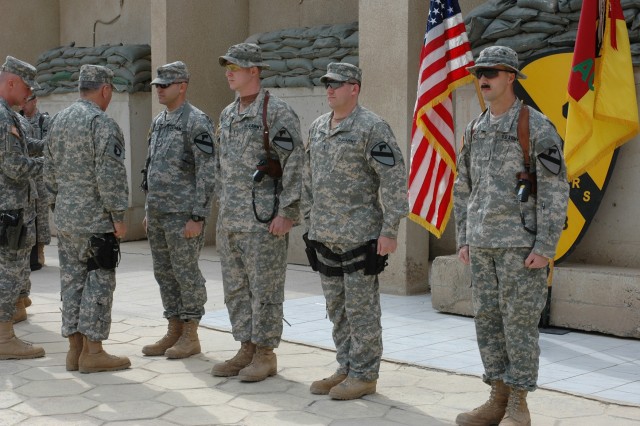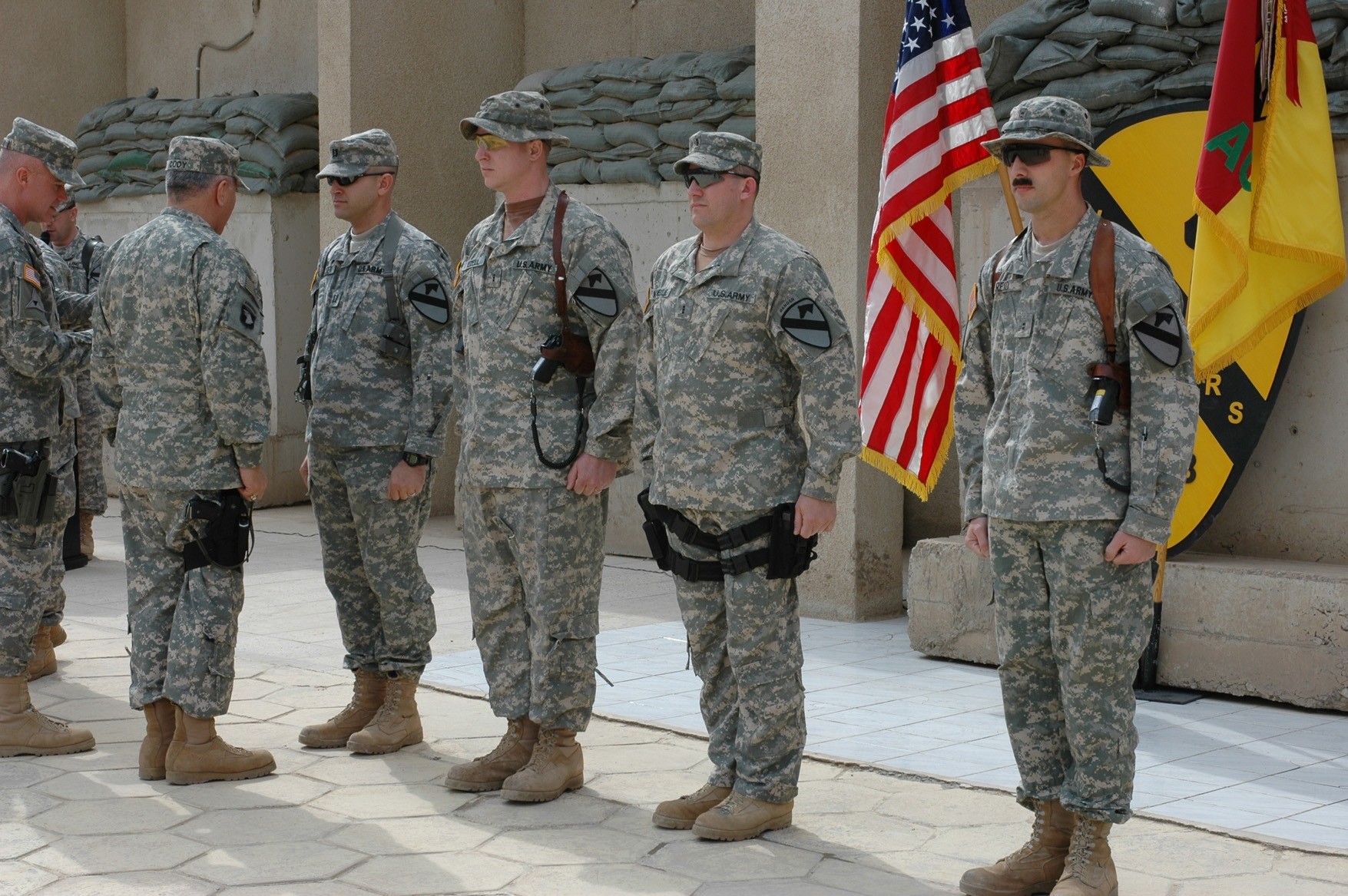
CAMP TAJI, Iraq - Although they will leave Iraq with their first awards for valor, the real reward for four pilots from the 1st Air Cavalry Brigade was doing their part to save the lives of many Soldiers on the ground in an engagement in December.
The pilots earned Air Medals with Valor for providing support to ground troops in contact with the enemy in an engagement that was like "something you would see in a World War II movie," according to Waxhaw, N.C., native Chief Warrant Officer 2 Rich Reid, the gunner and copilot for the trail aircraft during the engagement.
Reid, Capt. Matthew Carlsen and chief warrant officers 3 Les McNellie and Christopher Ezell comprised an air weapons team of two Apaches from 4th "Guns" Battalion, 227th Aviation Regiment, 1st ACB, 1st Cavalry Division, that responded to a call from troops in contact with the enemy.
About a month after their battalion's transfer of authority with the previous unit, they came upon a scene where all hell had broken loose. Two other air weapons teams had been on station to assist. One of the Apaches that had taken small arms fire made it back safely to Camp Taji and landed, despite having only one working engine.
"I think chaotic would be the best word to describe that, because one of our brothers was in the air, got (hit by enemy fire), had to come back here, make a single engine landing at Taji," said Carlsen, who hails from Twin Falls, Idaho.
At the time, the four pilots had been part of a small task force at Kalsu.
"We didn't know what was happening," Carlsen said. We were stationed down at Kalsu, so I think that added distance, separation - that detachment from the battalion main body - added to a little bit of that confusion."
The confusion didn't last long. Reid, from Waxhaw, N.C., got the team caught up on the situation on the ground by talking over the radio to Sgt. 1st Class Samuel R. Jackson, a Soldier from the ground unit. The pilots did not know the ground unit's designation.
"He (Jackson) was trying to paint the target picture: multiple grenade attacks from rooftops, small arms fire," said McNellie, a native of Jacksonville, Fla. "At that time, (Reid) had (positive identification) of two enemy personnel jumping from one rooftop to another."
The insurgents ducked into a building and Reid lost site of them. The ground forces continued to receive small arms fire and grenade attacks.
The four pilots waited in frustration for about 30 minutes, providing over watch as they waited for the ground forces to be able to move a safe distance away from the target area.
"About that time is when we learned about the single engine failure (of the Apache from a previous team supporting the ground fight) and that one of our sister aircraft had been engaged - taken small arms fire," McNellie said. "I relayed that to (Ezell and Reid, who were in the trail aircraft) and said: 'Whoa, this is getting pretty serious pretty quick.'
"(Reid) was doing a great job of talking to the ground guys, trying to get in there to get in the fight. We knew that once we started shooting, and we could put rounds on target, that these guys would either break contact or we would kill the enemy."
As they waited, they got word that Jackson had been hit by enemy fire.
"As soon as that happened, throughout our whole team, there was that sinking feeling of 'we're here now, we want to help. We can't help until you guys tell us we're clear to engage,'" McNellie said. "There was this eerie moment of silence amongst our team. Then, here comes (Jackson) - I remember to this day - comes back up on the net and goes: 'Hey guys, I'm currently going to be out of the fight. I got hit. I'm down, but I'm OK.'"
Jackson passed the Apache team off to his commander to continue the fight. The ground commander was able to clear his Soldiers away from the target area to allow the Apache crews to engage the enemy.
"We rolled in and did some precision diving fire," McNellie said. "We hit the front face of the building, which was where the majority of the small arms fire was coming from."
The crews made three passes engaging the same building, but the insurgents continued their attack, McNellie said.
The ground commander got clearance from his battalion commander to engage the building with a hellfire missile.
"They rolled in and (Reid and Ezell) did a ... hellfire engagement right through the roof of the building," McNellie said. "It was a perfect shot; the round went right where it needed to be."
Although fire ceased from that building, the ground unit soon came under fire from a different enemy position.
"They said they had multiple shooters and multiple personnel back on rooftops and on balconies," McNellie said. "I remember coming down the street and we were low ... at the time. I looked out the left door, and I remember just saying: 'Whoa!' T-72s and T-55s were just rocking with their guns. The humvees were shooting. The whole place was just getting lit up."
With the help of the ground commander, the pilots spotted the target - a building with a blue garage. As they came back to fire on the target, they spotted a humvee parked directly in front of the garage.
"I couldn't engage, because there was a humvee parked right in front of that blue garage," McNellie said. "That would have been a bad situation. I called (Ezell) immediately and said: 'Do not engage; do not engage."
Once the ground forces were clear of the building, the Apache team made another pass and engaged the building, suppressing enemy fire long enough for the ground forces to reach their rally points.
Ezell, who hails from Geneva, Ala., said he could remember the full range of emotions coming over the radio from the guys on the ground.
"From the beginning to the end, you can tell by changes in their tone of voice of how things are going," Ezell said. "You hear them kind of excited: 'We're taking fire!' It goes from that to 'This is working; this working.' They go from being in a black hole they cant get out of to: 'I can see a little light; I'm slowly getting there.' It's a good feeling to know (that we contributed to that)."
The engagement was - to this day, 10 months later - the most intense the team has been on.
"At that time, we had had maybe one or two engagements prior to this one, but this was the first close combat attack that our unit had had," McNellie said. "Since then, we've only had about two or three others."
"Up until this point (Dec. 1), we'd been flying in country for a little over about 30 days," Carlsen added. "We would get troops in contact where it was just a target of opportunity (for the enemy) on ground forces, and then they would break contact and melt away. We were there for about two hours, and throughout the engagement, the enemy was standing fast. They had no intention of removing themselves from that area."
Although the pilots received Air Medals with Valor for their actions - presented by Army Vice Chief of Staff Gen. Richard Cody - the messages from the ground unit held more meaning for them.
"Everyone knows why we do what we do - to preserve freedom," McNellie said. "When we're out there as aviators, and we are helping these guys on the ground, there is no award, no medal you can pin on your chest. The things I like' I've got three emails from ground commanders from over here this time, of when we've saved guys' ... lives - coming from either the guy on the ground himself or their brigade, battalion or company commander. Those emails mean more to me. Having them come in here, and they see us, and they look you square in the eye and tell you: 'Thank you, you saved our lives.' You could see it in their eyes. That right there says enough; that says it all."

Social Sharing